This twist on the traditional Nova Scotia Lighthouse Route brings you a fresh and fascinating road trip itinerary through Canada’s ocean playground.
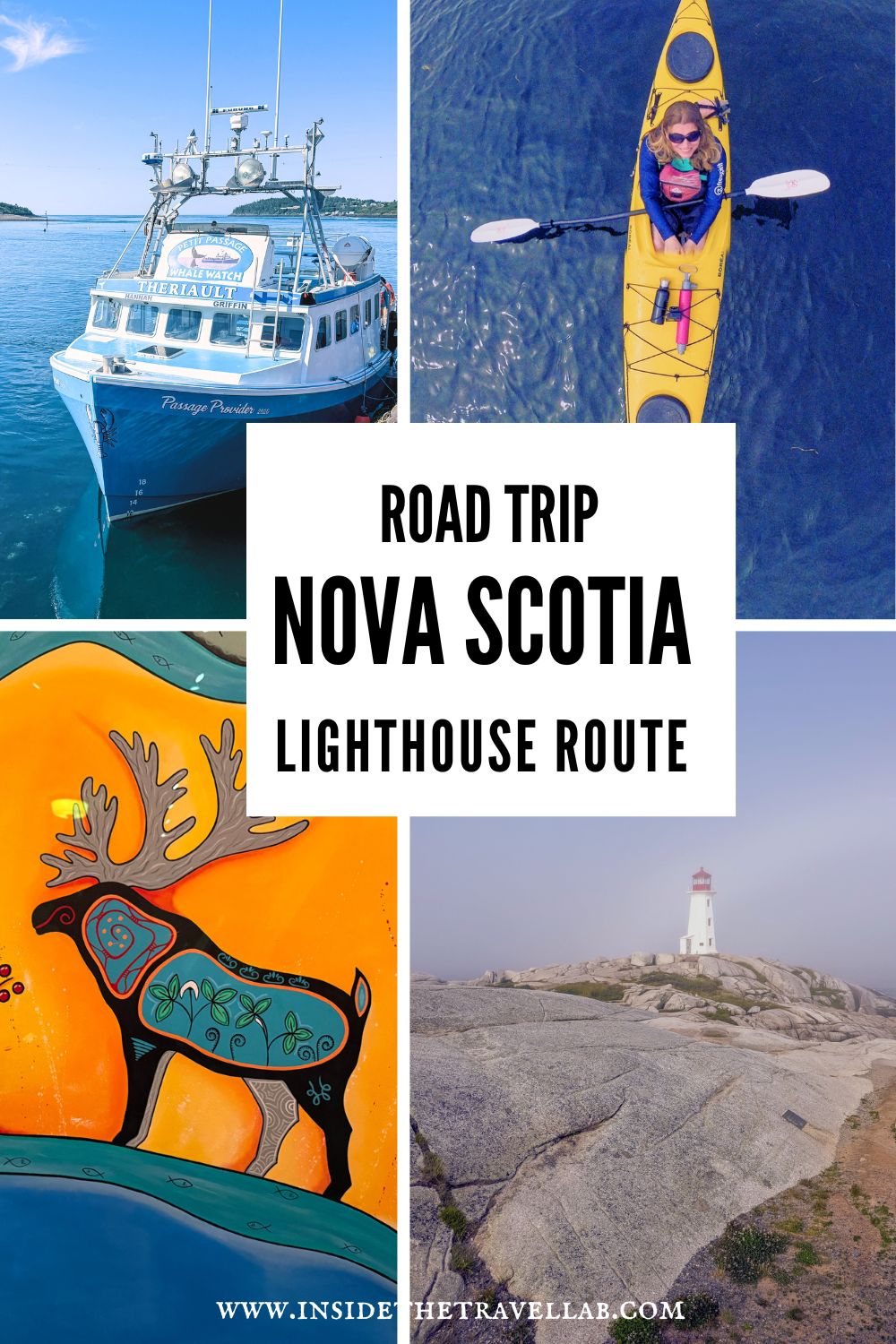

Nova Scotia’s Lighthouse Route and the Bay of Fundy
This summer saw me doing something which would have surprised my younger self: getting behind the wheel and taking a solo road trip through Nova Scotia.
Not because I never liked driving. On the contrary. But because when I was growing up, all I knew of Nova Scotia was in obtuse mentions during the icy Titanic rescue efforts and a joke to do with Poughkeepsie in Friends.
I hadn’t realised about the multiple UNESCO World Heritage Sites, the Lighthouses and secret coves, the whale watching adventures and bright art, bookshops and live music set amid a landscape so pristine it does actually look like the brochure.
Well, that’s the joy of travel (and aging, I suppose.) A million myriad ways to find out how wrong your younger self was.
As it turns out, this road trip through Nova Scotia was one of the best I’ve ever taken. So book yourself a hire car and get behind the wheel!
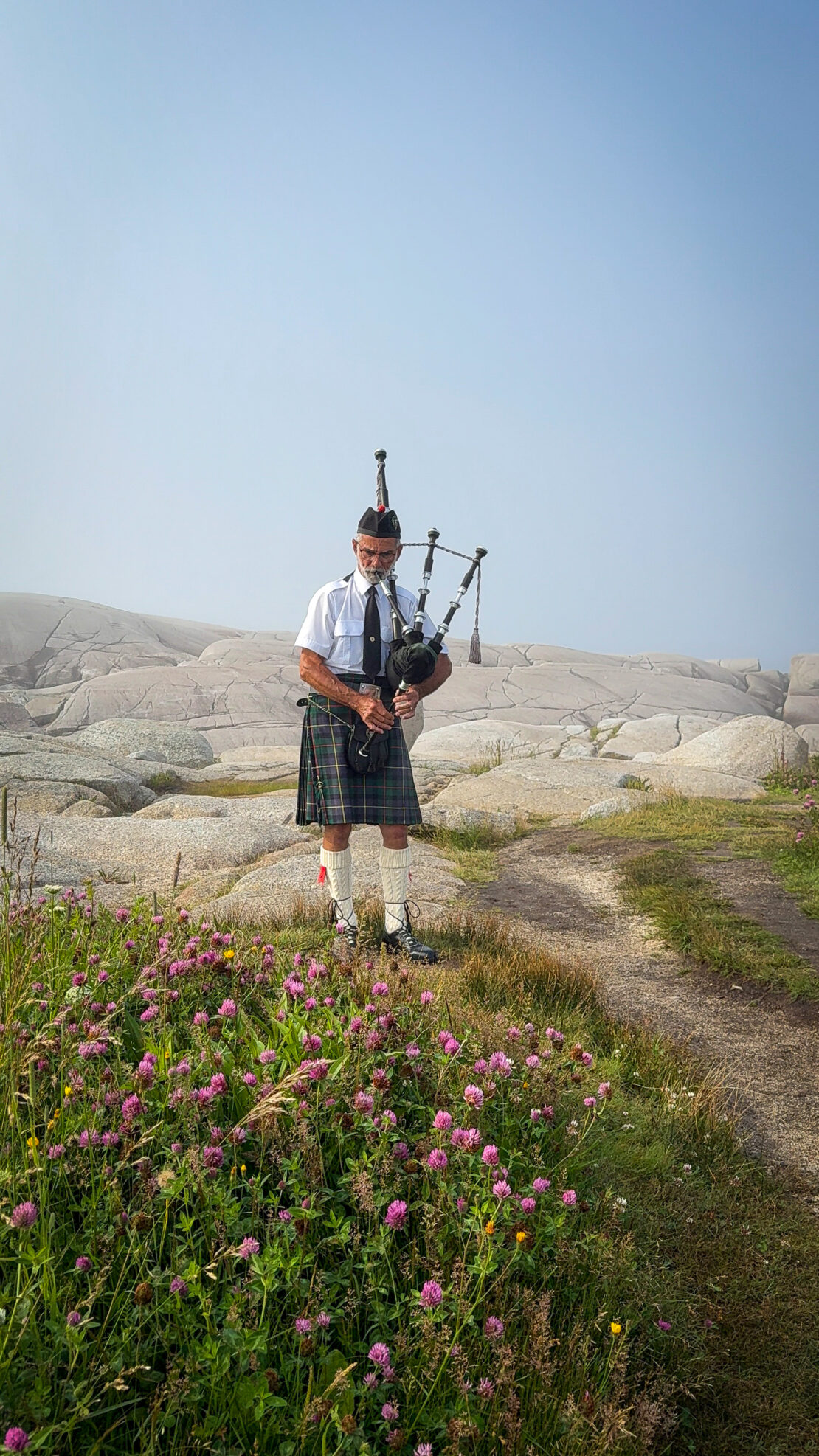

Why Road Trip Through Nova Scotia
First of all, why bother with all of this.
Well, for one, Nova Scotia is stunningly beautiful, with surf spray, lighthouses, whale tails and fishing villages so pretty it hurts.
It’s taken on the nickname of Canada’s Ocean Playground and is keen to remind you that with more than 13,000 kilometres of coastline, you’re never more than 60 km from the sea. That means plenty of lobster, kayaking, hiking and open water swimming.
But for me, the secret sauce is the sense of history. In one week alone, I visited three UNESCO World Heritage Sites in between all the fresh seafood and leg stretching adventure.
This one-week itinerary takes you from Halifax along Nova Scotia’s South Shore on part of the Lighthouse Route before heading north to Annapolis Valley and the Bay of Fundy before looping back again.
Let’s get to it.
Disclosure: I travelled as a guest of Tourism Nova Scotia for review purposes. However, as ever, as always, I kept the right to write what I like. Also, if you book or buy through any of the links on this page, we may earn a small commission at no extra cost to you. Cheers!


Who is This Nova Scotia Road Trip Itinerary For?
This itinerary is for travellers who want more than just pretty drives (although you will get plenty of those.)
It’s for those curious about history and culture, who want to taste Digby scallops at the source, hear Mi’kmaq stories along the shoreline, wander through UNESCO-listed towns, and watch the Bay of Fundy tides sweep fishing boats metres into the air.
We’ve kept the daily drives short (usually under two hours) making it ideal for anyone looking for a mix of activity and downtime without feeling rushed. It’s also ideal for a solo trip for this reason and most evening eateries are within walking rather than driving distance.
You’ll need to be fairly active, though, for the kayaking and hiking and many (most? all?!) of the historic properties lack elevators, so you’ll need to be able to carry your own luggage up and down several flights of stairs.
Elsewhere, though, Canada is more like the US in that pavements and walkways are well maintained and flat, parking is easy, museums and vineyards have elevators and so on. Restaurants usually have lists of ingredients and allergens and the like and the area has an excellent safety record.
In short: it’s a road trip for travellers who love food, heritage, and the sea without too much of a challenging drive along steep or rural roads.
Heads up! Unlike many of my other road trip itineraries in North America, this one isn’t designed with young kids in mind. Children can take part in almost all of it and Nova Scotia is a great place for a family road trip with short drive times, white sandy beaches and easy parking in small towns. However, there are age limits for kayaking and whale watching may not be the best fit for teeny ones. However, it is one of those bucket list road trips and with a few tweaks, this scenic route would work for young families too. I’ll make a note of when you need to modify.
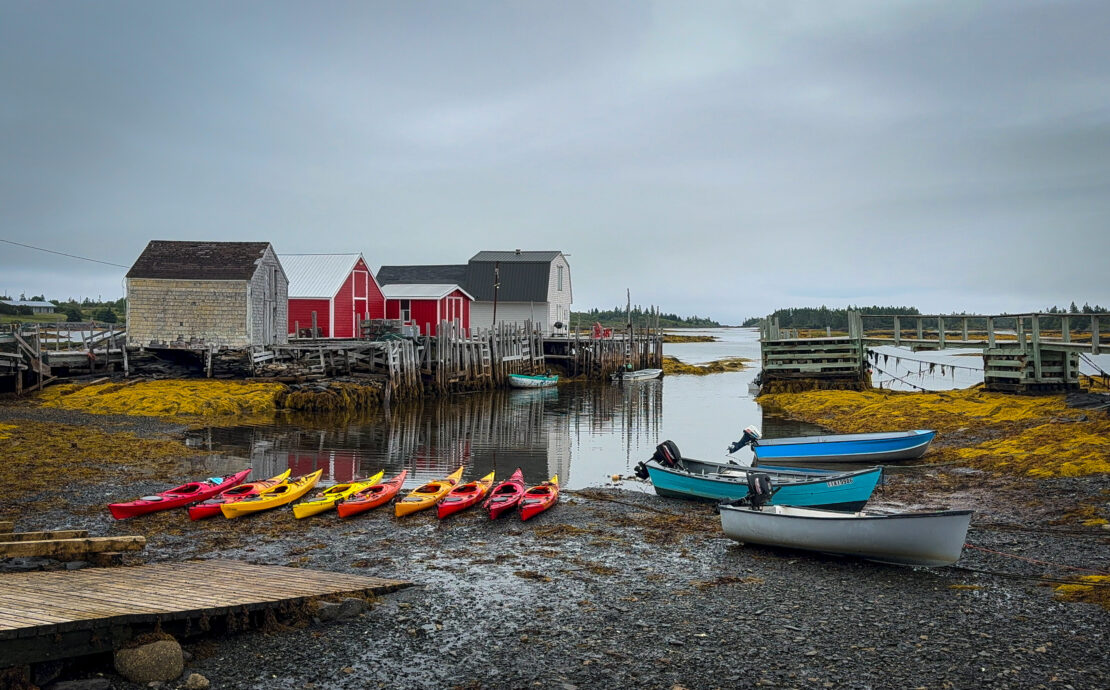

Travel Essentials
- Route: Start and finish in Halifax, tracing the South Shore Lighthouse Route before heading north to the Bay of Fundy, and Annapolis Valley. Plenty of scenic drives.
- Duration: 7–8 days (with optional extension to Cape Breton or Yarmouth).
- Transport: you’ll need to book ahead to collect your car from Halifax Stanfield International Airport.
- Accommodation: Choose “home bases” like Lunenburg or Wolfville for two nights to reduce packing fatigue.
- Top Tip: early breakfasts are harder to find than I expected (before 8) so stock up on some snacks if you want to get up and hit the road.


Driving in Nova Scotia
Driving in Nova Scotia is straightforward, even for international visitors (it’s a far cry from the swerves and hairpin bends of the mountains of Morocco and Andalusia, for example.)
Roads are generally quiet outside of Halifax, with well-marked highways and scenic coastal roads.
Like so much of the world, people drive on the right. This takes a bit of getting used to if you’ve not done it before but I’d say that Nova Scotia is one of the easiest places to learn to do this.
What to Know:
- Fuel: it’s generally easy to find petrol stations, apart from the stretch when moving from the south to north shore. Top up when you can!
- Speed limits: Posted in km/h (100 km/h on highways, 50 km/h in towns).
- Wildlife: Moose and deer occasionally cross roads, especially at dawn and dusk, so avoid driving at those times.
- Parking: Easy and inexpensive outside Halifax in general, although metered and a bit more of a faff in city centres like Lunenberg.
- Ferries: Small car ferries (like the LaHave River crossing) are part of the adventure.
- Car Rental: it’s simple to pick up and drop off at the main airport in Halifax. If, like me, jet lag hits you hard, you can spend a few days in Halifax and then head back to the airport to pick up the car.
With a car, you can can stop at beaches and tiny fishing villages whenever you want, spend as much time in each destination as you wish and stop for photos whenever the mood strikes. It also makes it easier to sling a full tripod into the back and generally spread out with as much gear as you need!
Need more advice? Don’t miss our ultimate road trip planning guide.
What to Pack for Nova Scotia
Rather like Britain, Nova Scotia’s weather is famously changeable. A sunny morning can quickly give way to sea fog or an ocean breeze that bites. Pack layers and you’ll be comfortable in all conditions.
- Layers: T-shirts, fleeces, and a waterproof jacket.
- Comfortable shoes: For towns, coastal walks, and forest trails.
- Water gear: Swimsuit, quick-dry towel, and water shoes for kayaking or beach days.
- Binoculars & camera: For whale watching and bird spotting.
- Insect repellent & sunscreen: Coastal hikes and inland trails can bring both sun and bugs.
- Smart casual outfit: For winery tastings or dining out.


Mi’kmaq Heritage along the Nova Scotia Lighthouse Route
I’m far from an expert on this topic but I do feel it’s important to try to cover it. Long before the settlers arrived, Nova Scotia was home to the Mi’kmaq people, whose presence here stretches back thousands of years.
Here are some of the best spots along this route to take in their heritage:
- Halifax Waterfront – look for art installations that acknowledge that the harbour sits on unceded Mi’kmaq territory and visit the Sipekne’katik Treaty Truckhouse on the waterfront to learn more.
- Fisheries Museum of the Atlantic, Lunenburg – a section on Mi’kmaq fishing practices explain some of the sustainable traditions that pre-date European settlement.
- Art in Halifax – The Art Gallery of Nova Scotia features works by Mi’kmaq artists past and present, from intricate quillwork and basketry to contemporary painting and sculpture. Definitely worth a visit.
- Kejimkujik National Park – In the central section of the park, you can see Mi’kmaq petroglyphs carved into stone. Some of these are thousands of years old. Trails and interpretation panels provide context for this sacred landscape but you do need to arrange a local guide to see them.
Day By Day Nova Scotia Road Trip Itinerary


Day 1: Arrival in Halifax
- Drive: Nil – arrive and settle in.
My in-laws always told me that Halifax is one of their favourite cities. And while I was a little perplexed at first, once I arrived, I understood it.
Halifax is a city that grows on you, so, ideally you’d spend a couple of days here getting over jet lag and starting to uncover the rich history of the region.


If time is tight, however, you can see the “famous” spots in one day. With more time on your side, move beyond downtown Halifax into the quirky smaller neighbourhoods and take a trip outside the city to see the UNESCO World Heritage Site of Africville.
However, with only one day, here’s how to spend it:
- Wander the Halifax waterfront boardwalk, climb up to Citadel Hill National Historic Site, and pause in the Victorian elegance of the Public Gardens.
As night falls, order seafood fresh from the Atlantic and watch the harbour lights flicker across the water. This is just the beginning – I’m currently writing up our full Halifax guide, with more ideas for museums, neighbourhood cafés, and hidden corners worth exploring. Watch this space!
Stay: The Prince George Hotel, central Halifax, within easy walking distance of the main sights. Be warned, though, Halifax is hilly so you’ll need some stamina!
Halifax and the Titanic
When the Titanic sank in 1912, Halifax became the centre of recovery operations. Cable ships from the city were sent out to retrieve victims and wreckage from the icy North Atlantic.
Many of those who lost their lives are buried in Halifax cemeteries, including Fairview Lawn Cemetery, where simple grey headstones mark the resting place of more than 100 Titanic victims.
At the Maritime Museum of the Atlantic, you’ll find one of the world’s most significant Titanic collections, from a child’s shoes to fragments of the ship itself. Walking through the exhibits offers a poignant reminder of Halifax’s role in one of the most famous maritime tragedies of all time.
For a deeper dive into seafaring history, head to the Maritime Museum of the Atlantic. Here you’ll find model ships, naval relics, and poignant exhibitions on the Titanic and the 1917 Halifax Explosion, events that shaped both the city and the wider world. I’m embarrassed by how little I knew about it.


The Halifax Explosion
On the morning of 6 December 1917, Halifax was the site of the largest man-made explosion in history before the atomic bomb. A French munitions ship, the Mont-Blanc, collided with another vessel in the harbour. Laden with explosives bound for the First World War front, it caught fire and drifted toward shore before erupting in a catastrophic blast.
The explosion flattened much of Halifax’s north end, killing around 2,000 people and injuring thousands more. Windows shattered 100 kilometres away, and a tsunami swept through the harbour minutes later.
You can’t spend long in Halifax without hearing about this event – and the fondness the city has for Boston, who reacted quickly to provide immediate aid.


Day 2: Halifax → Lunenburg via Peggy’s Cove
- Distance & Drive Time: 120 km / 1h 45m
The first day of this road trip through Nova Scotia is picture perfect, the road weaving through pine trees and coastal views, dotted with cute little cabins.
The first stop, of course, has to be at Peggy’s Cove, where the famous lighthouse perches on smooth granite rocks, battered by waves and on the edge of a small fishing village.
It’s sweet whenever you turn up but if it’s really important to you to either get a great photo or to have the place yourself, then you need to either get up early or head out at sunset a day earlier from Halifax. To say that it’s popular is an understatement, the crowds start to arrive by nine and it only gets busier after that.
Don’t lose yourself in the photo, though. Always remember to keep off the black rocks as rogue waves claim tourists each year.
Just a little further along the road is the SwissAir Memorial Site, if you want to pay your respects.
Chester
Pause in Chester for its Nordic spa (book ahead) or in Mahone Bay to admire the “three churches” lined up along the waterfront and to try a slice at the Famous Town Pie Shop.
Your destination is Lunenburg, a UNESCO World Heritage Site, living museum and Nova Scotian beauty pageant winner (no mean feat in an area speckled with pretty little towns.)
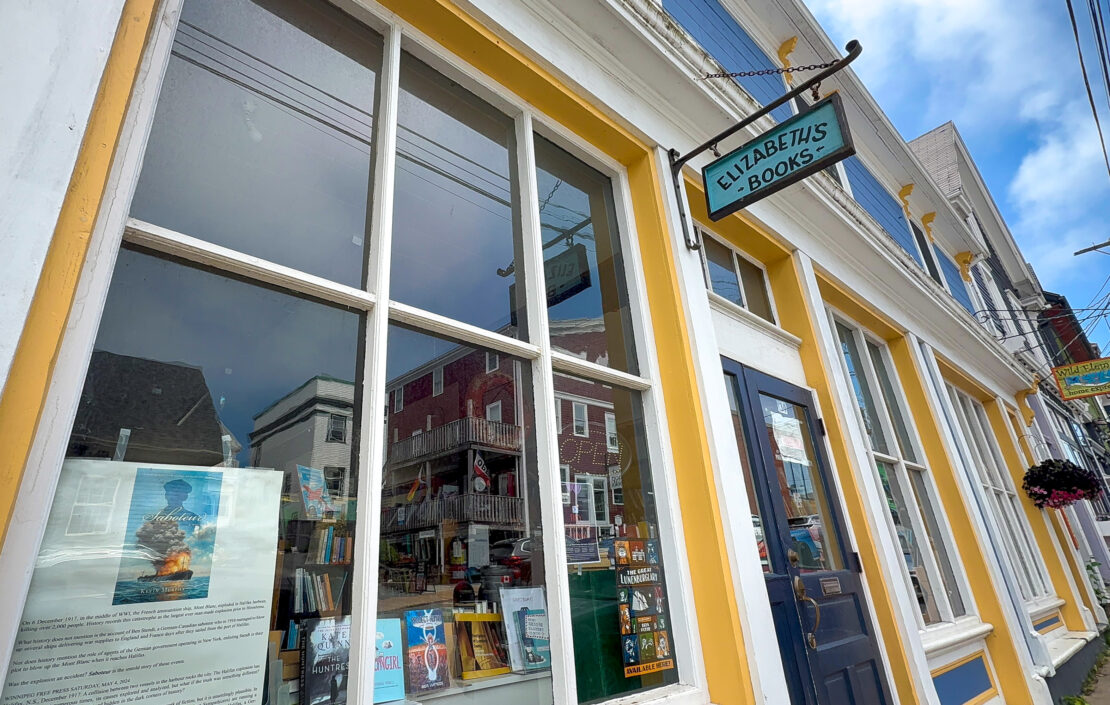

Lunenberg
Welcome to a town filled with colourful wooden houses and browsable book shops.
Don’t miss the Fisheries Museum of the Atlantic, brimming with marine biology, working boats, and stories of the fishermen who shaped this coast. That includes the Mi’qmaq, French, and British, as well as modern Canadians.
Curiously, it’s UNESCO World Heritage Status stems from its role as a prototype for British town planning. Fellow Brits will know that proper town planning is notably absent from the British Isles, and it turns out that this plan came from Swiss and German architects under protection of the British Crown.
- Stay: The Kinley House, a heritage B&B in Lunenburg with a small self catered area just a short walk out of town.
- Top Tip: for the best views of Peggy’s Cove Lighthouse, leave early and make sure you’re there before nine. It’s one of the region’s most popular places.


Day 3: Lunenburg & Kayaking with Seals
- Distance & Drive Time: 20 km all together / 30m each way
It’s time to hit the water! Head out to Blue Rocks, a teeny tiny fishing village where brightly painted shacks cling to seaweed strewn shores. From here, join a Pleasant Paddling kayak tour through a maze of islets, looking for harbour seals.
Back on land, loop through Bridgewater for a wander at the quirky BernArt Maze, or stop in Liverpool, once notorious for pirates and privateers.
I took the LaHave Ferry instead of the main highway, a fun way to cross the mighty river, with a gorgeous coffee shop and deli on the other side. Check out the Nova Scotia road trip video for the inside story.


Day 4: Summerville Beach → Kejimkujik → Annapolis Royal
- Distance & Drive Time: 80 km / 2h 45m
This part of the Lighthouse route is where you hit the white sands of Summerville Beach. Of course, Nova Scotia like its namesake Old Scotia, attracts the weather vengeance of the gods from time to time.
You can see what it was like when I was there (misty, foggy, grey) but it’s still refreshing to stride along the beach, umbrella in hand. And most of the time in summer, I’m told, it’s dry white sand and blue shores.
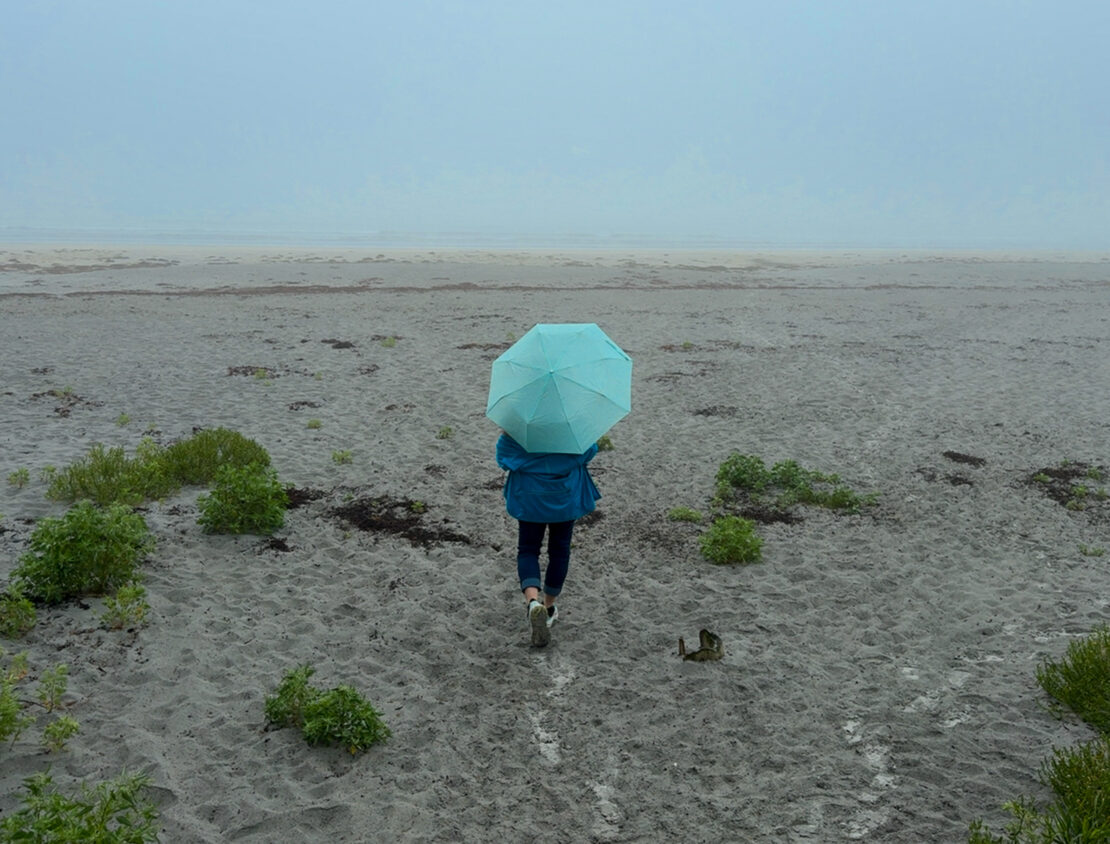

Kejimkujik National Park
If the weather doesn’t play along, it’s worth stopping off inland at Kejimkujik National Park on route to the north. Here, you can find a range of hiking trails and glacial lakes, enough to lose yourself in for days.
Or, luckily, you can find a short one-hour hiking route to get a taste of the area.
With some planning in advance (which I sadly missed) you can join a guide to see the Mi’kmaq petroglyphs. You can also drive to scenic viewpoints within the park for a taste of Nova Scotia’s wilder interior – and find great spots for a picnic. (As a side note, you won’t find many eateries between the coast on this route so stock up or use the visitor centre in the park.)
Will you get the whole Canadian wilderness experience this way? Not exactly. But it fits well enough into the itinerary to get a taste.
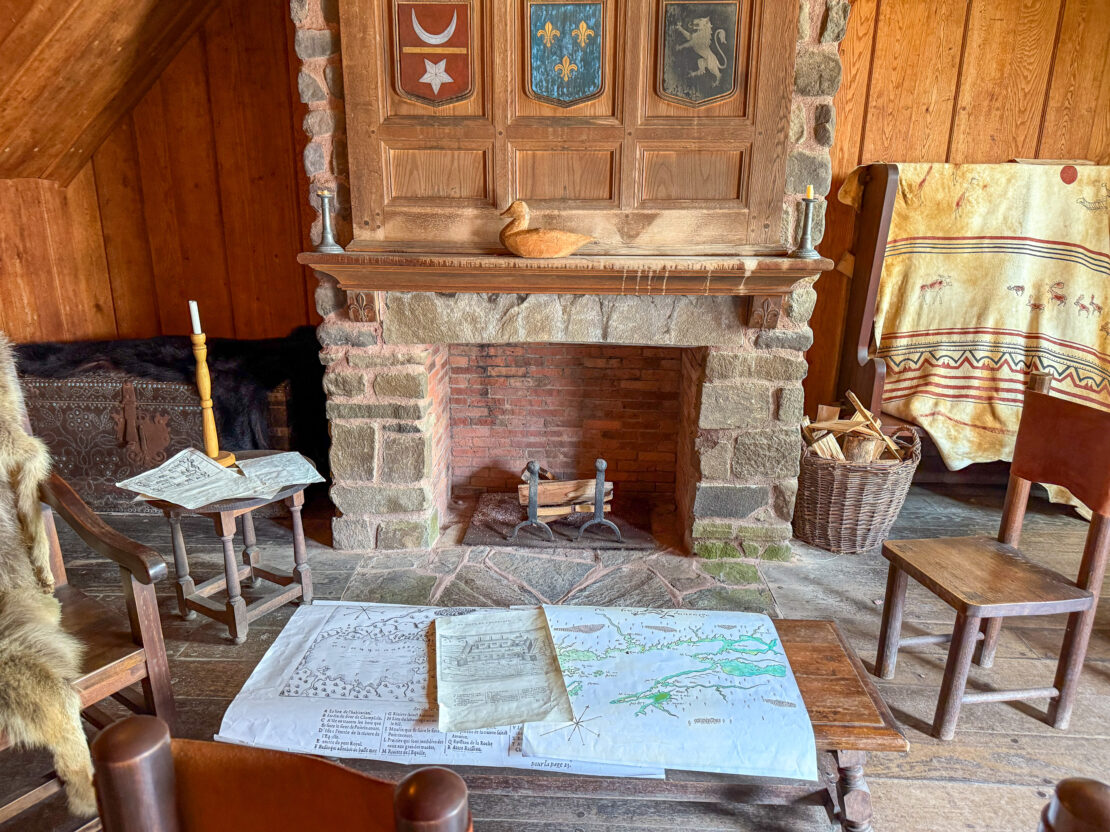

Annapolis Royal
By afternoon, arrive in Annapolis Royal, a settlement that dates back to the early 1600s. Visit the Historic Gardens or walk along the riverbank to see remnants of Canada’s earliest European colony.
There are a lot of great historic things to see near here, so you’ll need to be strategic. If you’re running short of time, I’d opt for Port Royal out of the two biggies that follow, but if you’re feeling keen (as I was!) you can just about squeeze in both.
Fort Anne & Port Royal
Fort Anne National Historic Site is the oldest national historic site in Canada, housed in the original 18th-century ramparts and outlining the struggles between the Mi’kmaq, French, British, and Acadians.
A short drive away, Port Royal National Historic Site recreates one of North America’s earliest European settlements, complete with timber buildings, costumed interpreters, and demonstrations of daily life in the early 1600s. This second spot is the livelier of the two, thanks to the costumed guides, even though it requires another drive to reach it.
Back in Annapolis Royal, the summer evenings fill the riverside with sunshine and the sound of live music. But I’d suggest booking any restaurants well in advance – it’s the one place I really struggled to find a table on the night.
- Stay: Queen Anne Inn, an 1865 Victorian mansion oozing with history and comfortable for an overnight stay.
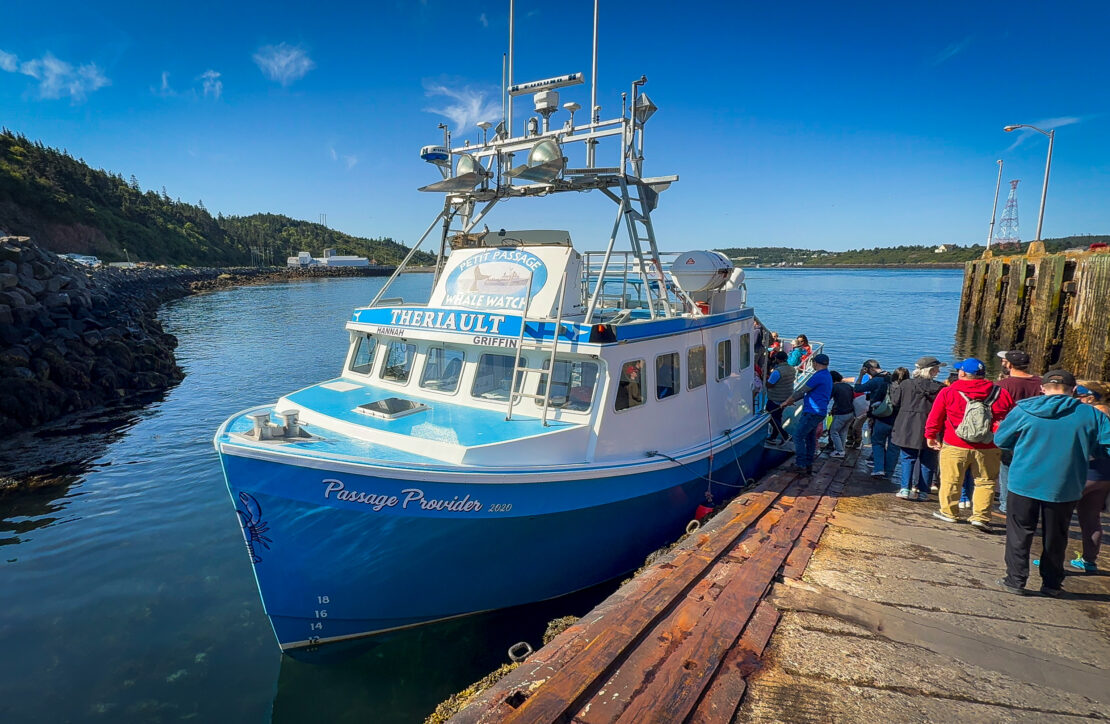

Day 5: Annapolis Royal → Digby → Bay of Fundy Whale Watching → Wolfville
- Distance & Drive Time: 120 km / 1h 45m
If it’s not lighthouses, it’s wales. This is signature Nova Scotia stuff.
Drive west towards Petit Passage to join a whale-watching cruise into the Bay of Fundy.
If you’re lucky, you’ll see humpbacks, minkes, and porpoises – as we did – but if lady luck is not on your side then just relax and enjoy the blue, blue skies and calm waves in the meantime.
Back on shore, make time for lunch in Digby, home of the world-famous Digby scallops.
Sweet and delicate, these scallops are best enjoyed pan-fried with butter or tucked into a chowder. If, like me, dairy is off the menu, though, don’t worry. Digby serves scallops almost every way you can imagine them, so the chowder need not frighten you away!
From there, wind east through the fertile Annapolis Valley to Wolfville, a refined university town surrounded by vineyards. You’ll feel more sophisticated just by osmosis.
- Stay: Tattingstone Inn, Wolfville. A luxurious and beautifully decorated historic property – and probably my favourite of the whole trip.
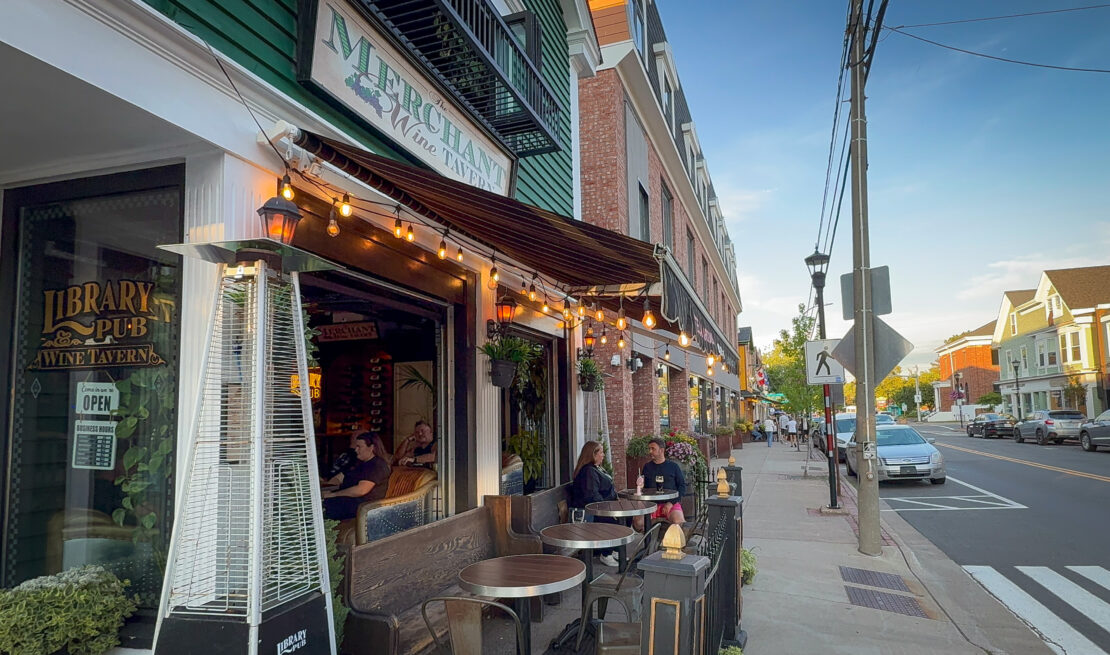

Day 6: Wolfville & Hall’s Harbour Lobster Feast
- Distance & Drive Time: 50 km there and back / ~1 h total
Time for another UNESCO World Heritage Site today, with a trip to the Grand Pré National Historic Site, where a simple church and wooden cross mark the Acadian deportation of 1755, a sobering yet essential chapter in the province’s history.
Then, in the afternoon, explore the surrounding vineyards and tasting Tidal Bay, Nova Scotia’s signature crisp white wine.
If you really want to go wine tasting, you can book a tour as it’s obviously not wise to drink and drive. Alternatively, the vineyards are beautiful to visit without drinking and you can walk into Wolfville to try the local specialty in the evening.
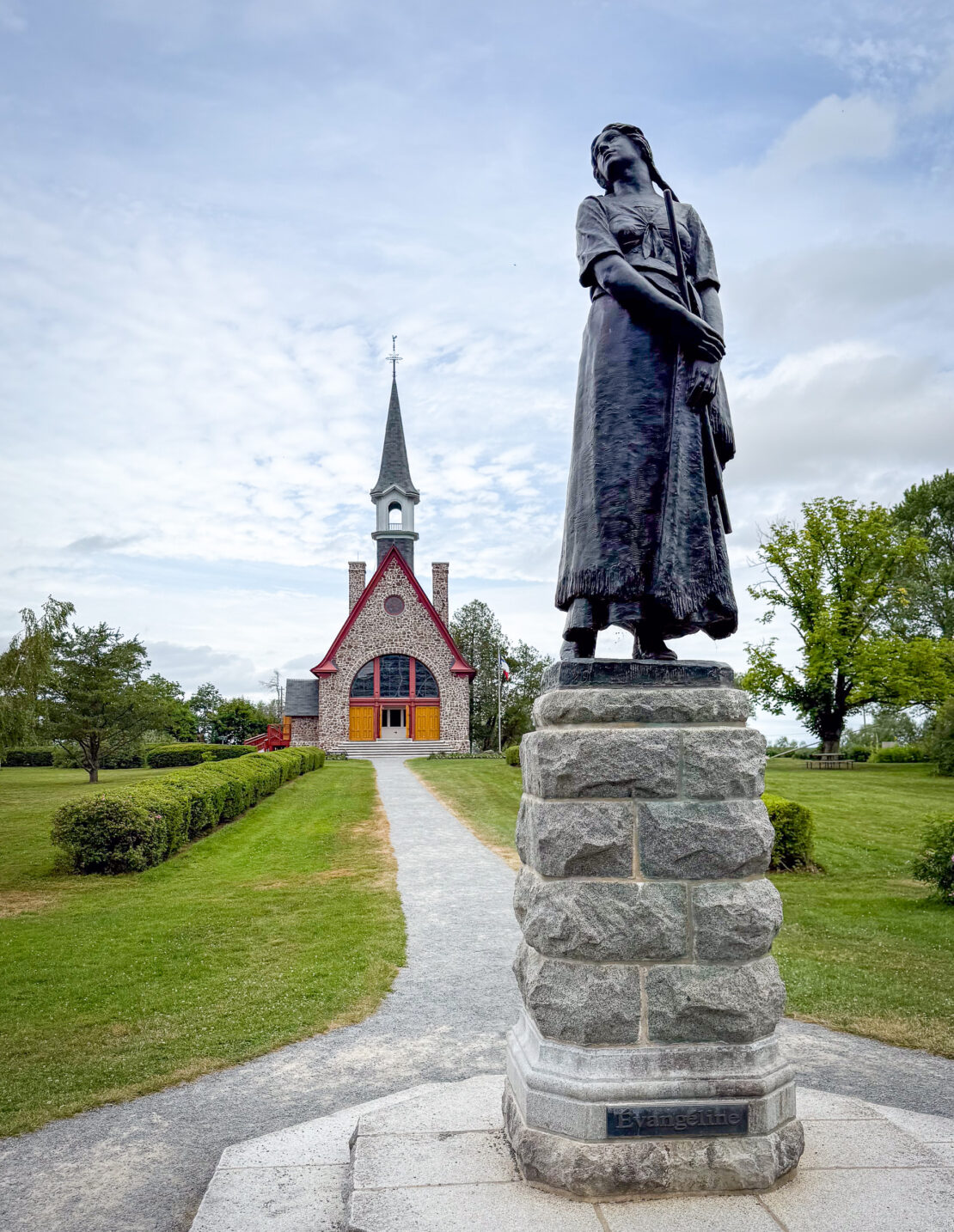

The Importance of the Acadians
The story of the Acadians, the French-speaking settlers who arrived in the 1600s, is one of those core things to know about when visiting the Annapolis Valley and the Bay of Fundy.
Here’s the short version or crash course.
For over a century, Acadians lived alongside the Mi’kmaq, learning how to navigate the tides and seasons. They reclaimed farmland from the sea with an ingenious dyke system, creating fertile fields that still feed the region today.
However, the on again off again wars between France and England tore at this hard earned peace and neutrality, with each European side demanding loyalty to their crown.
Eventually, everything changed in 1755 with the Grand Dérangement (Great Expulsion), when British forces deported thousands of Acadians from Nova Scotia. Families were torn apart, communities destroyed, and people scattered across North America, with some ending up in Louisiana, where their descendants became known as Cajuns.
Don’t miss a trip to the Grand Pré National Historic Site, which has exhibits and videos to bring the past to life.


Lobster
As the tide shifts, drive out to Hall’s Harbour. Here, you’ll pick your lobster fresh from the pound and have it cooked in seawater before sitting down at a waterfront table. And if you’ve never done that before and don’t (ahem) exactly know what to do, then, not to worry. The staff will take pity on you and help you out. This spot ships lobsters all around the globe, so it’s a fascinating window into another world.
Watch as fishing boats rest on mud flats at low tide, then float metres higher by the end of your meal. This may not sound impressive as you read it now, but trust me. It is impressive to see and is one of the best places for a final stop before heading home.


Day 7: Wolfville → Halifax Return
- Distance & Drive Time: 130 km / 1h 45m
It’s time to head back to Halifax. Depending on your flight, you might pause at a vineyard or take one last coastal walk before returning your car at the airport. If you don’t have time for that, try another Canadian classic and pick up a Tim Horton’s en route.
- Stay: Either overnight in Halifax or fly home.
Optional Day 8 Extension: Cape Breton or Yarmouth
If you have extra time, extend your journey:
- Cape Breton Highlands National Park: tackle the Cabot Trail, with cliffside roads, Gaelic traditions, bald eagles, and dramatic ocean views from Cape Breton Island.
- Yarmouth: explore quieter fishing villages, ferry connections, and lighthouses framed by rugged headlands. Hit Cape Forchu: the perfect place for photographers.
- New Brunswick: walk among the towering flowerpot rocks at Hopewell Rocks Provincial Park, explore the Fundy Trail Parkway with its sweeping coastal views, and experience the same mighty tides from a new perspective.
- The Eastern Shore: a less-travelled stretch where the Atlantic Ocean feels raw and endless. Discover hidden surf beaches, kayaking routes among wild islands, and small communities where Mi’kmaq and Acadian stories mingle with the rhythms of the sea.
- Prince Edward Island (PEI): just a short ferry or bridge ride away, PEI offers rolling farmland, crimson beaches, and an irresistible literary connection as the home of Anne of Green Gables. Cycle along coastal trails, feast on mussels and oysters, and soak up the island’s slower rhythm of life.


At a Glance: Drive Distances & Times
| Day | Route | Distance (km) | Drive Time |
|---|---|---|---|
| Day 1 | Arrival in Halifax | – | – |
| Day 2 | Halifax → Lunenburg (via Peggy’s Cove) | ~120 | ~1h 45m |
| Day 3 | Lunenburg → Blue Rocks → Lunenburg | ~20 return | ~1h total |
| Day 4 | Summerville Beach → Kejimkujik → Annapolis Royal | ~180 | ~2h 45m |
| Day 5 | Annapolis Royal → Digby → Wolfville | ~120 | ~1h 45m |
| Day 6 | Wolfville → Hall’s Harbour → Wolfville | ~50 return | ~1h total |
| Day 7 | Wolfville → Halifax | ~130 | ~1h 45m |
| Day 8 | Optional extension to Cape Breton or Yarmouth | Varies | Varies |
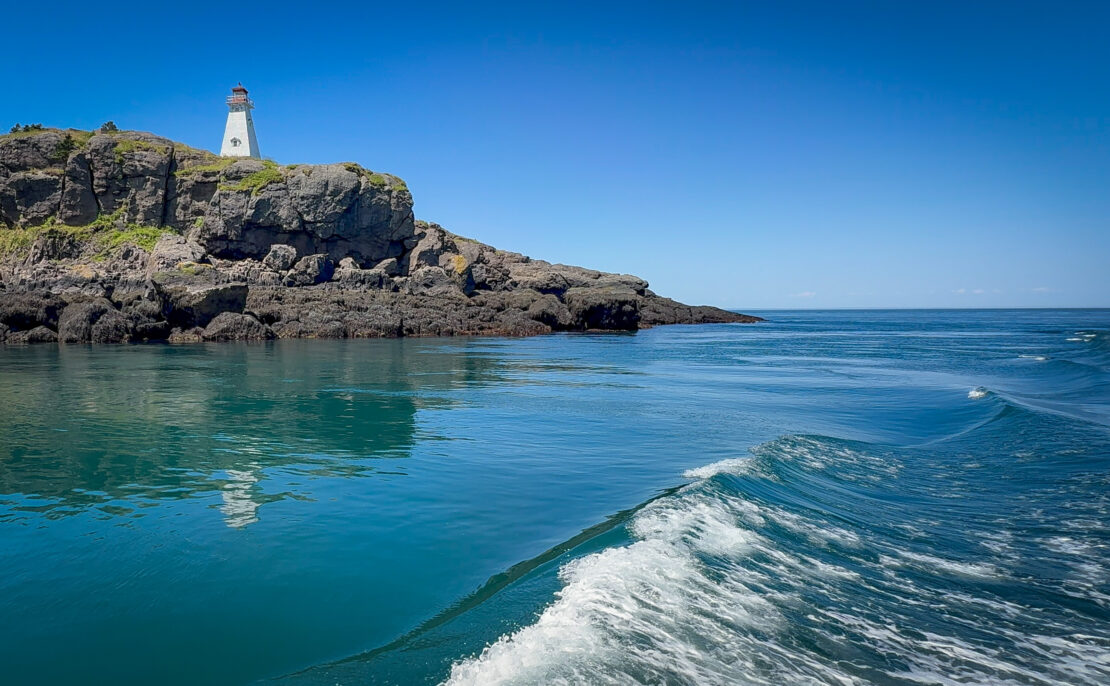

Final Thoughts about Nova Scotia
This Nova Scotia road trip distils what makes the province unforgettable: colourful fishing villages, timeless lighthouses, and flavours drawn straight from the sea.
I was amazed at how much history there is to uncover and how many household names, like the Titanic, blast away the idea of this being a frosty, remote, barren stretch of land.
It’s one of the worst travel writing cliches you can come up with, to say that you want to go back and to see a place some more. But I’m getting too old to care about such things.
I loved my time in Nova Scotia. And I do want to go back and see some more.
In the meantime, I hope you get to do the same.
Cheers, Abi
More About North America

